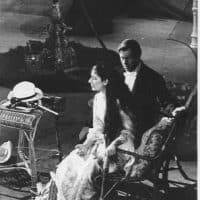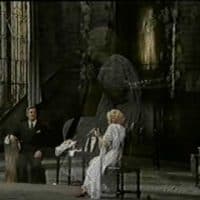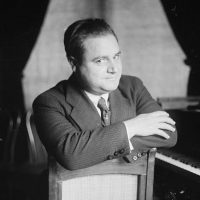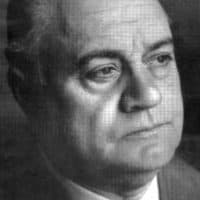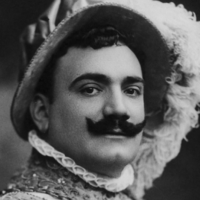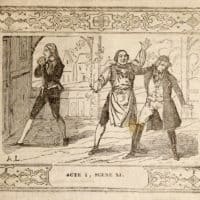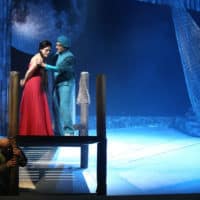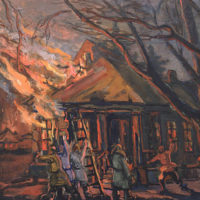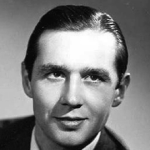 Cesare Siepi was born in Milan on February 10th 1923. As he himself repeatedly stated, he was largely self-taught and only for a short time attended the Conservatory of Milan. In 1941 he gave his stage debut in the part of Sparafucile in „Rigoletto“ in Schio near Venice. World War II prevented further engagements for the time being. As an active opponent to the fascist regime Siepi escaped to Switzerland in 1943, where his voice was discovered and his talent encouraged in an internation camp, just as was the case with his countryman, Giuseppe Di Stefano. When War was over he lost no time in reassuming his career and had a sensational success in 1945 as Zaccaria in „Nabucco“ at the Teatro La Fenice in Venice. In the following year already he gave his first appearance at the Scala of Milan: most sources give his Scala debut in the role of Sparafucile (with Carlo Tagliabue and Jussi Björling) on August 20th 1946, the Scala´s chronology already lists him in a performance of „Aida“ on August 9th in the role of Ramfis. In 1947 Siepi took part in the world premiere of Ildebrando Pizzetti´s “L´Oro” and was heard in “Nabucco”, “Don Carlo” (then as gran inquisitore with Tancredi Pasero as the King), “La Bohème”, “Die Meistersinger von Nürnberg” (Pogner) and “Mignon”. 1948 marked the 30th anniversary of Arrigo Boito´s death and Arturo Toscanini asked Siepi to sing the title role in “Mefistofele” and the role of Simon Mago in “Nerone”.
Cesare Siepi was born in Milan on February 10th 1923. As he himself repeatedly stated, he was largely self-taught and only for a short time attended the Conservatory of Milan. In 1941 he gave his stage debut in the part of Sparafucile in „Rigoletto“ in Schio near Venice. World War II prevented further engagements for the time being. As an active opponent to the fascist regime Siepi escaped to Switzerland in 1943, where his voice was discovered and his talent encouraged in an internation camp, just as was the case with his countryman, Giuseppe Di Stefano. When War was over he lost no time in reassuming his career and had a sensational success in 1945 as Zaccaria in „Nabucco“ at the Teatro La Fenice in Venice. In the following year already he gave his first appearance at the Scala of Milan: most sources give his Scala debut in the role of Sparafucile (with Carlo Tagliabue and Jussi Björling) on August 20th 1946, the Scala´s chronology already lists him in a performance of „Aida“ on August 9th in the role of Ramfis. In 1947 Siepi took part in the world premiere of Ildebrando Pizzetti´s “L´Oro” and was heard in “Nabucco”, “Don Carlo” (then as gran inquisitore with Tancredi Pasero as the King), “La Bohème”, “Die Meistersinger von Nürnberg” (Pogner) and “Mignon”. 1948 marked the 30th anniversary of Arrigo Boito´s death and Arturo Toscanini asked Siepi to sing the title role in “Mefistofele” and the role of Simon Mago in “Nerone”.
At the Scala the singer shared most of the bass roles with Tancredi Pasero and became his successor until he left for the Metropolitan Opera. “Aida”, “La Gioconda” and “La Favorita” were the operas he sang in 1948 and a new role at the Scala during the following season was Pater Guardian in “La Forza del Destino”. In 1950 he appeared in “La Bohème”, “I Puritani”, “Samson et Dalila”, “Aida” and as Pistola in “Falstaff”. Until 1979 Siepi regularly returned to Milan´s Opera House, even though, especially in later years,  in greater intervals: in 1955 in “Simone Boccanegra” and “Don Giovanni” (with Stella, Schwarzkopf, Carteri and Tajo under Otto Ackermann), 1956/57 in “La Forza del Destino” and 1957/58 in “Mefistofele” and “Anna Bolena” (with Maria Callas). His farewell performance was as Fiesco in “Simone Boccanegra”. Sir Rudolf Bing offered him, not without some roundabouts, the role of King Philipp in “Don Carlo” on the occasion of his first season´s opening night in 1950 at the MET. To cast this role Bing had gone through considerable trouble: shortly before the American Congress had approved the McCarran Act, which made the scheduled debut of Boris Christoff at the MET impossible since Christoff was a Bulgarian citizen and was refused entry permit into the U.S. Neither Mihaly Szekely, who was not allowed to leave Hungary, nor Gottlob Frick, who did not seem acceptable to Bing because of his political past, brought a solution to this dilemma. A European agent established the first contact between Bing and then 27-year-old Siepi. As Bing recalled later he gave a loud groan when he read the address of Siepi´s home in Milan: Via Moscova . . . For Siepi the opening night became an overwhelming success and he was given the honour of also opening the following season with “La Forza del Destino” (with Richard Tucker and Zinka Milanov).
in greater intervals: in 1955 in “Simone Boccanegra” and “Don Giovanni” (with Stella, Schwarzkopf, Carteri and Tajo under Otto Ackermann), 1956/57 in “La Forza del Destino” and 1957/58 in “Mefistofele” and “Anna Bolena” (with Maria Callas). His farewell performance was as Fiesco in “Simone Boccanegra”. Sir Rudolf Bing offered him, not without some roundabouts, the role of King Philipp in “Don Carlo” on the occasion of his first season´s opening night in 1950 at the MET. To cast this role Bing had gone through considerable trouble: shortly before the American Congress had approved the McCarran Act, which made the scheduled debut of Boris Christoff at the MET impossible since Christoff was a Bulgarian citizen and was refused entry permit into the U.S. Neither Mihaly Szekely, who was not allowed to leave Hungary, nor Gottlob Frick, who did not seem acceptable to Bing because of his political past, brought a solution to this dilemma. A European agent established the first contact between Bing and then 27-year-old Siepi. As Bing recalled later he gave a loud groan when he read the address of Siepi´s home in Milan: Via Moscova . . . For Siepi the opening night became an overwhelming success and he was given the honour of also opening the following season with “La Forza del Destino” (with Richard Tucker and Zinka Milanov).
He became the legitimate successor of Ezio Pinza and stayed with the MET during the following 23 seasons until 1974. New roles at the MET included “Boris Godunov”, which he sang in English, and Gurnemanz in “Parsifal” (1970 in German!). Siepi´s first appearance as Don Giovanni at the Salzburg Festival was a sensation, which he repeated there during the years to follow. Don Giovanni is probably the role he is best remembered for and which up to our days has remained a model-interpretation. Among his most famous portraits also were King Philipp, as already mentioned, both Gounod- and Boito-devils, Don Basilio and Pater Guardian. In 1953 he took part in a film version of “Don Giovanni” done by Herbert Graf which was filmed in the Felsenreitschule in Salzburg and there was heard in “Don Carlo” in 1958 under the direction of Herbert von Karajan (with Jurinac, Bastianini, Fernandi and Simionato). In 1950 he had given his debut at the Covent Garden Opera in London and regularly appeared there in the years between 1962 and 1973. At the Italian Summer Festivals in Verona and Macerata he was a regular guest, he received offers from all major international opera houses and was an internationally acclaimed concert singer. In later years he also turned his attention to American Musical, “South Pacific” by Rodgers and Hammerstein, for example, in which he was as successful as Ezio Pinza had been before him. Well into the Eighties he was heard at the opera houses of San Francisco and Seattle, at the Teatro Comunale in Florence, the Teatro Regio in Parma 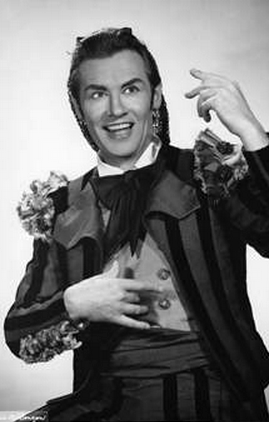 and the Teatro San Carlo in Naples. Still in 1994 (!) the Viennese public had the pleasure of hearing Siepi in a concert performance of Bellini´s “Norma”. Cesare Siepi today lives in the United States. Siepi´s career was an exceptionally long one and apart from some wear and tear in later years, the voice remained largely intact until the end. The voice might have lacked some of the sonority and the velvety timbre of his predecessor, Ezio Pinza, or the massive power of Boris Christoff, but he by far exceeded the latter in terms of elegance and flexibility. Siepi was a basso cantante in the best sense of the word, his phrasing was intelligent and well-dosed.
and the Teatro San Carlo in Naples. Still in 1994 (!) the Viennese public had the pleasure of hearing Siepi in a concert performance of Bellini´s “Norma”. Cesare Siepi today lives in the United States. Siepi´s career was an exceptionally long one and apart from some wear and tear in later years, the voice remained largely intact until the end. The voice might have lacked some of the sonority and the velvety timbre of his predecessor, Ezio Pinza, or the massive power of Boris Christoff, but he by far exceeded the latter in terms of elegance and flexibility. Siepi was a basso cantante in the best sense of the word, his phrasing was intelligent and well-dosed.
In early years, as some time witnesses and colleagues remarked, the voice was not well balanced yet and sounded a little unsteady, which Siepi, intelligent singer that he was, soon was able to improve by growing experience during the course of his career. The tenor, Giacomo Lauri Volpi, promised Siepi in his book “Voci parallele” a glorious career, but noted that he had a general tendency, especially the top notes, towards singing too open. Cesare Siepi´s aristocratic stage appearance and his histrionic talent, Giulietta Simionato who was his frequent partner on stage called him the grand seigneur of the operatic stage, made him a perfect interpreter of the noblemen, kings and priests of the bass repertory. Maybe another quotation from Giacomo Lauri Volpi describes best Cesare Siepi´s effect on his public: “He has found the melody in the depth of his soul.” (“Ha trovato la melodia in fondo dell´anima.”)
